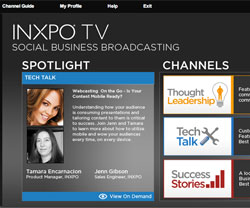Give Face-to-Face Attendance a Virtual BoostFebruary 1, 2013
Mastering the Hybrid Meetings Balancing Act By George SeliGive Face-to-Face Attendance a Virtual Boost
Mastering the Hybrid Meetings Balancing ActIn recent years, a certain risk has been stereotypically associated with virtual meetings. It’s often characterized by the rather unpleasant word “cannibalization.” The worry is that the virtual event will siphon away many of the live convention’s potential attendees who chose to stay comfortably and cost-effectively in their homes (or home offices) and take in all the content from their computers. The unwanted results include attrition, weaker traffic flow for exhibitors and a less vibrant networking scene.
Virtual Marketing
But the truth is that most association members recognize that remote attendance is not the ideal way to participate in the meeting: They want to experience that famous speaker while seated among their peers; they want to make a more personal connection with colleagues and exhibitors. Instead, virtual attendance is a welcome option only when they can’t fit the travel time into their busy schedules, or if they can’t attend relying on their own funds. It’s also a nice option when they want to get a sense of the content being offered, before making the decision to attend in person. In that case, elements such as webcasts of educational sessions, virtual trade shows, online networking with other attendees and real-time Q&As with presenters all serve to “advertise” the real convention. The virtual meeting effectively says, “All of this is what you could be experiencing in that more compelling, face-to-face way.”
INXPO, a major provider of virtual event solutions, has some data to confirm that promotional effect. “We’ve been working with PCMA for several years, and we did a survey to determine how many people attended 2012 Convening Leaders based on their 2011 Convening Leaders virtual participation,” says Scott Kellner, chief marketing officer with INXPO. “Fourteen percent said that their virtual experience had directly led to their decision to attend in person. Some hadn’t even been (at the face-to-face meeting) in the last five to six years.” Any small cannibalization effect that a virtual meeting might have would surely be offset by the new face-to-face attendees it draws to the next convention, as these stats suggest.
Most recently, a post-meeting survey from PCMA’s 2013 Convening Leaders hybrid event revealed that attendees were 63 percent more likely to attend a future PCMA face-to-face event because of the hybrid experience.
And there is anecdotal evidence that virtual attendance can foster the desire to participate in person. Marian Long, CMP, is director of meeting services with another of INXPO’s clients, the Chicago-based American Association of Diabetes Educators (AADE). “My first virtual meeting experience was PCMA about three years ago,” Long recalls. “Two colleagues from my department had gone to Las Vegas for the event, and I attended virtually.” To a degree, Long did get a sense of a shared experience with those colleagues. “It was great just going back and forth with them while they were in the general session: ‘I’m not feeling it with the speaker, are you guys? How is it live?’ One of the speakers was just not resonating with me, and I thought maybe it was just me. ‘No, she’s not doing very well here either,’ they said.” But apparently the virtual interaction with her colleagues was less than ideal. “I felt like I was kind of there, but not really. And it did make me want to participate the following year live, which I did.”
Added Value
AADE’s national convention in August will be its 40th, and will be paired with its virtual meeting for the third time. Long and Meetings Coordinator Erin Luytjes say they have thus far seen no evidence of cannibalization, and feel that the virtual event is mainly a resource for members who can’t always attend in person. A health care organization might only be able to send two out of six diabetes educators to the convention each year, for example. “We’re just looking at it as another member benefit, giving them a chance to feel like they’re still part of the meeting without having to be there,” Long explains. “If a member can’t be there we understand it, because we already have a history 40 years going (with many members) rotating in every two to three years.”









 And yet it’s more than regular TV in that participants have the ability to interact and discuss the content. That feature also makes Social Business TV more dynamic than an online knowledge center, a common tool for associations. Like a knowledge center, Social Business TV “enables you to go in and download content, but you don’t do it in a vacuum,” Kellner explains. “There is a reason we put the word ‘social’ in the title’s product. It enables a great deal of interaction to take place both among the audience as well as between the audience and the program host. You can also do surveys and moderated Q&A. All these things can make a presentation much more meaningful to an audience.”
And yet it’s more than regular TV in that participants have the ability to interact and discuss the content. That feature also makes Social Business TV more dynamic than an online knowledge center, a common tool for associations. Like a knowledge center, Social Business TV “enables you to go in and download content, but you don’t do it in a vacuum,” Kellner explains. “There is a reason we put the word ‘social’ in the title’s product. It enables a great deal of interaction to take place both among the audience as well as between the audience and the program host. You can also do surveys and moderated Q&A. All these things can make a presentation much more meaningful to an audience.”